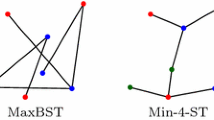Abstract
A geometric spanning tree of a point set S is a tree whose vertex set is S and whose edge set is a set of non-crossing straight line segments with endpoints in S. Given a set of red points and a set of blue points in the plane, the red/blue spanning tree problem is to find a geometric spanning tree for red points and a geometric spanning tree for blue points such that the number of crossing points of the two trees is minimum. If no three points are collinear, we show that the minimum number of crossing points is completely determined by the number of maximal red chains on the convex hull of all red points and blue points. We design an optimal algorithm for constructing a geometric spanning tree of all the red points and a geometric spanning tree of all the blue points with the minimum number of crossing points. If collinear points are allowed, we prove that the problem of deciding whether there exists a geometric spanning path of all the red points and a geometric spanning path of all the blue points without crossing is NP-complete.
Preview
Unable to display preview. Download preview PDF.
Similar content being viewed by others
References
Brodal, G.S., Jacob, R.: Dynamic planar convex hull. In: Proceedings of the 43rd Annual IEEE Symposium on Foundations of Computer Science (FOCS 2002), pp. 617–626 (2002)
Chazelle, B.: On the convex layers of a planar set. IEEE Transactions on Information Theory IT-31, 509–517 (1985)
Fary, I.: On straight line representations of planar graphs. Acta Sci. Math. (Szeged) 11, 229–233 (1948)
Garey, M., Johnson, D.: Crossing number is NP-complete. SIAM J. Algebraic and Discrete Methods 4, 312–316 (1983)
Hliněný, P.: Crossing number is hard for cubic graphs. Journal of Combinatorial Theory, Series B 96, 455–471 (2006)
Author information
Authors and Affiliations
Editor information
Editors and Affiliations
Rights and permissions
Copyright information
© 2009 Springer-Verlag Berlin Heidelberg
About this paper
Cite this paper
Bereg, S., Jiang, M., Yang, B., Zhu, B. (2009). On the Red/Blue Spanning Tree Problem. In: Chen, J., Cooper, S.B. (eds) Theory and Applications of Models of Computation. TAMC 2009. Lecture Notes in Computer Science, vol 5532. Springer, Berlin, Heidelberg. https://doi.org/10.1007/978-3-642-02017-9_15
Download citation
DOI: https://doi.org/10.1007/978-3-642-02017-9_15
Publisher Name: Springer, Berlin, Heidelberg
Print ISBN: 978-3-642-02016-2
Online ISBN: 978-3-642-02017-9
eBook Packages: Computer ScienceComputer Science (R0)




